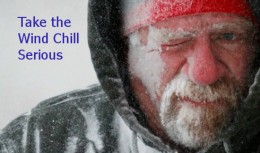 Do you sometimes think that those reporting the weather are just being overly dramatic when reporting the wind chill factor?
Do you sometimes think that those reporting the weather are just being overly dramatic when reporting the wind chill factor?
If so, you are not alone…but the wind chill factor can be a serious factor; and, with temperatures in Oakland, Wyckoff and Franklin Lakes about to plummet, it is a good time to appreciate how the wind chill factor is factored.
The wind chill factor, first developed in 1940 by polar scientists Paul Siple and Charles Passel, was born out of their experiments on the cooling rate of a small plastic bottle as water turned to ice while hanging in the wind outside their expedition hut in the Arctic.
In 2001, a new formula developed by American and Canadian scientists was adopted in North America and the United Kingdom. The motivation for developing a more rigid formula was because the scientists were sick and tired of hearing hysterical television reporters tossing around wind chill numbers simply for the fear factor — actually, that’s only partially true.
Many scientists believed the old formula slightly over exaggerated the wind chill factor, and with more exaggeration from weather reporters – they were concerned that people would not take the wind chill factor serious at all…and the wind chill factor is serious.
First, for math and meteorologist fans, here’s the formula:
Wind Chill = 35.74 + 0.6215T – 35.75(V^0.16) + 0.4275T(V^0.16)
T is the air temperature in degrees Fahrenheit, and V is the wind speed in miles per hour.
The reason that the wind chill factor is not just fodder for news headlines is because the faster skin cools, the faster frostbite sets in.
The new wind chill formula came from experiments with a group of 6 men and 6 women who volunteered for clinical trials held in a refrigerated wind tunnel built to emulate real world conditions. Basically, the wind chill factor you hear reported assumes that your exposed face is roughly five feet off the ground, it’s night, and you’re walking directly into the wind in an open field at a clip of about 3 mph.
If you plan on being outside for more than a very short period, take into account the wind chill factor and how the cold temperature can threaten your health.
Hypothermia:
- Body temperature falls below 35 C.
- Symptoms include drowsiness, impaired co-ordination and weakness.
- It can also be fatal.
Frostbite:
- Result of skin freezing.
- It causes swelling, redness, tingling and burning.
- Skin turns white and waxy as the frostbite progresses.
- Infection and loss of extremities can result.
Frostnip:
- Ice crystals form under the skin.
- Chilblains occur when bare skin is exposed to cold water, or when wet skin cools.
- The skin itches and swells.
- Chilblains can lead to gangrene.
Links:
http://mentalfloss.com/article/26730/how-wind-chill-calculated
http://www.weatherimages.org/data/windchill.html
( Chart and Calculator)
http://www.cbc.ca/news/canada/the-science-of-wind-chill-1.819530
